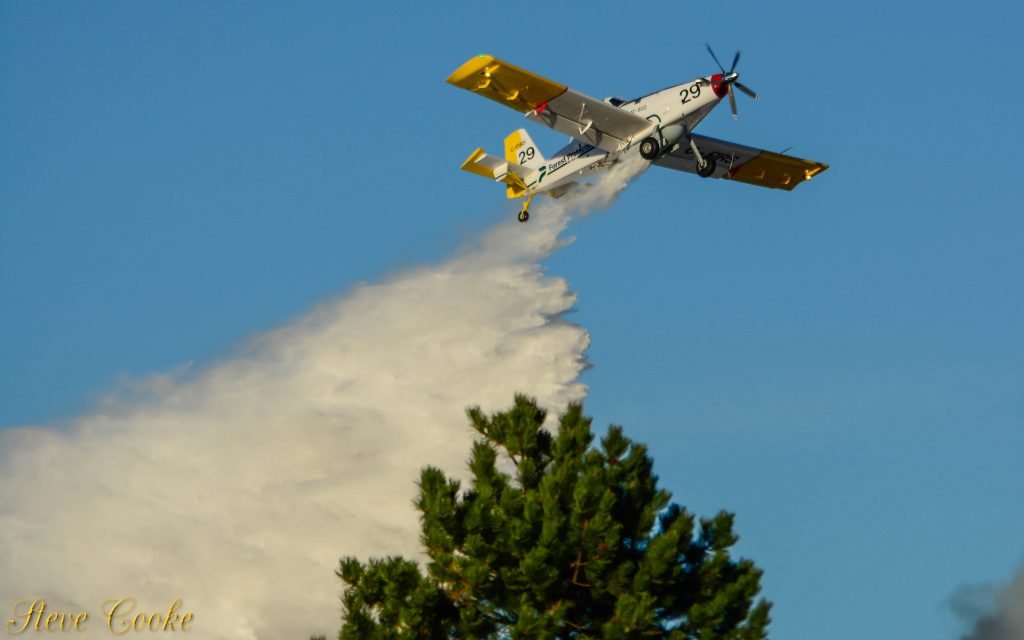A large part of forest management is aerial forest fire management. This process encompasses planning, preventing and actively fighting fires to protect property, people and forest resources. This year our teams primarily responded to fires in New Brunswick (NB). A lot goes into preparing for forest fire season, keep reading to learn more about the behind-the-scenes work that goes into protecting our forests!
PRESEASON TRAINING
Our pre-season preparation occurred throughout the off-season to facilitate the largest attended training session in Forest Protection history. The week before Easter long weekend Forest Protection training pilots reviewed the training plan and performed their onboarding refreshers. The rest of our pilots started their ground school training the following week, over a five-day period. Our teams learned about various topics including our company corporate policies, aircraft manuals, best health and safety practices, fire behaviour and Crew Resource Management case studies.
The next phase of training occurred over three weeks where pilots underwent a series of vigorous training flights. With approval from their trainer, each pilot moved on to the next air lesson plan. All pilots were successful in their ground and flight training, and a completion ceremony was held on April 29. By taking the lessons learned from last year, our teams were able to complete the training before the commencement of our fire season on May 1st.
FIRE AND AERIAL TREATMENT OPERATIONS
This year was the first year that our teams were completely based in Fredericton. Our teams had the ability to day-base throughout the province with respect to the fire weather index and as directed by the province’s Department of Natural Resources.
The month of May saw a total of 5 responses from our teams. The first fire was not until May 20 and was in the southern region of our province. The month of June was like last year’s operations, being the most difficult month to balance fire response/standby with SBW treatment. The peak of the extreme fire index happened to align with the SBW program based in Charlo and in Newfoundland. Daily coordination between NB’s Department of Natural Resources and Forest Protection was critical to maximize the resources available. To ensure that we had enough support aircraft, Forest Protection contracted a Cessna 208 Caravan to assist with fire and timber management operations.
Continuing into July, we saw a lot of rain – with most of our days being low fire alert statuses. August took a turn for one of the drier months, with both of our teams being put on high fire alert status. Our season ended shorter than last year, wrapping up mid-September. It’s safe to say our operating season this year was more typical to NB’s past ten-year average fire weather than our last season, as we responded to a total of 13 fires compared to last year’s 43 fire responses.
ACHIEVEMENTS
Scaling up from last season, Forest Protection purchased two additional AT-802 aircraft, which included new Electronic Flight Information System (EFIS) panels, new Generation 3 (Gen 3) firebombing doors, and Gen 3 equipment. The AFM was updated across the fleet and crews were trained on the aircraft differences.
Further to the AT-802 fleet documentation and training, the Forest Protection Chief Pilot increased aircrew training by introducing weekly professional development briefings to ensure the continuation of learning through a wet season. Some Aircrew deployed to USA airspace to develop procedures for both hasty and deliberate operations. Due to the differences between Transport Canada and the US Federal Aviation Administration (FAA) regulations and procedures, training is vital to retain international flight operations currency. Training will increase as we start to investigate more opportunities within the US.
Throughout the 2020-2021 off-season, the Director of Flight Operations led the refinement of the Emergency Response Manual in consultation with various government and industry stakeholders. Multiple Tabletop Exercises (TTX) were conducted to ensure that our teams were prepared before the beginning of the operational season. Next year Forest Protection will have the opportunity to engage external agencies for additional TTX training. The Director of Flight Operations also updated the Company Operations Manual and Air Operators Certificate to include Transportation of Dangerous Goods, enabling Forest Protection for future operations.
The staff at the NB Provincial Forest Firefighting Centre made significant bounds for aircraft dispatch methods. Previously only phone calls or emails launched the crews, but this year an official text message dispatch was used to launch our crew to fires and practice training flights. It was a significant milestone for timely message transfer. To build on lessons learned from last season, Shadow Pilot and Loader Training occurred over a week at the start of the season, led by the Ground Operations Manager. The Fire Support Operations Superintendent wrote a reload base manual to coincide with the training and accompany the Shadow team to any reload base in New Brunswick. The manual is essential to ensure all crew are aware of the different pumps and configurations between bases.
Though it has been a quiet season in terms of fires, our teams stayed busy with continuation training and improving standard operating procedures. We look forward to our next operational season and continue to dedicate ourselves to protecting Eastern Canada’s forests.

